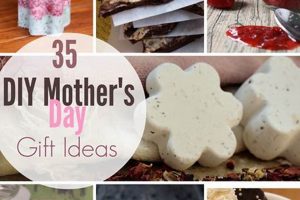Preparations containing dried fruits, spices, and herbs, intended for simmering in water to release aromatic scents, represent thoughtful, homemade presents. These fragrant blends serve as natural air fresheners, offering a customizable and aesthetically pleasing alternative to commercially produced products. For instance, a common combination includes dried orange slices, cinnamon sticks, cloves, and star anise, packaged attractively for gifting.
The practice of gifting aromatic mixtures for home fragrance dates back centuries, with variations found in different cultures. Presenting these natural scent solutions holds several advantages. They provide a non-toxic method to enhance indoor air quality, create a welcoming ambiance, and offer a personalized touch reflective of the giver’s care. Furthermore, the ingredients often possess inherent therapeutic properties, contributing to relaxation and stress reduction.
The subsequent sections will delve into the specific components suitable for inclusion, methods for preparing and packaging these fragrant offerings, and creative approaches to personalize the gifting experience, ensuring the resulting item is both appreciated and effective.
Essential Guidance for Crafting Aromatic Home Fragrance Presents
The following recommendations provide valuable insights for preparing effective and well-received homemade aromatic gifts. Careful consideration of ingredient selection and presentation enhances the overall gifting experience.
Tip 1: Ingredient Quality: Source high-quality, fresh spices, dried fruits, and herbs. Substandard ingredients yield weaker aromas and a less visually appealing final product.
Tip 2: Scent Combination Harmony: Balance warm and cool scents. Combining citrus with spices creates a balanced and appealing fragrance profile. Avoid overpowering combinations that may cause olfactory fatigue.
Tip 3: Drying Methods: Ensure fruits are thoroughly dried to prevent mold growth. Employ a dehydrator or low-temperature oven setting for optimal results. Insufficient drying compromises product longevity.
Tip 4: Packaging Considerations: Utilize airtight containers or cellophane bags to maintain ingredient freshness and prevent scent dissipation. Decorative jars or muslin bags enhance the aesthetic appeal.
Tip 5: Inclusion of Instructions: Provide clear and concise usage instructions. Specify the appropriate water-to-mixture ratio and simmering time for optimal fragrance release. Indicate safe simmering practices.
Tip 6: Allergen Awareness: Label potential allergens, such as cinnamon or citrus, to accommodate recipients with sensitivities. Transparency regarding ingredients promotes responsible gifting.
Tip 7: Consider Shelf Life: Note the anticipated shelf life on the packaging. Properly dried and stored mixtures can last several months, but fragrance intensity may diminish over time. Indicate a “best by” date for optimal enjoyment.
Adhering to these guidelines ensures the creation of a thoughtful and effective aromatic gift, contributing to a pleasant and welcoming home environment for the recipient.
The subsequent section offers guidance on creating bespoke fragrance blends for specific occasions and personal preferences.
1. Ingredient Selection
Ingredient selection constitutes a foundational element in the creation of homemade aromatic preparations. The quality, type, and combination of components directly influence the resulting scent profile, potency, and overall effectiveness. Thoughtful consideration of these factors is paramount to producing a desirable and impactful offering.
- Fragrance Profile Determination
Specific ingredients contribute distinct olfactory notes. Citrus peels introduce bright, uplifting aromas, while spices like cinnamon and cloves impart warmth and depth. Floral elements, such as dried lavender or rose petals, add delicate and soothing tones. The careful selection of components dictates the final fragrance composition. For example, a blend of apple slices, cinnamon sticks, and nutmeg creates a scent reminiscent of autumn, while a combination of lemon peel, rosemary, and thyme provides a refreshing, herbaceous aroma.
- Aroma Intensity and Longevity
The potency of individual ingredients varies significantly. Essential oil-infused components often release a more concentrated aroma compared to standard dried herbs or spices. The presence of resins or woody elements can contribute to a longer-lasting scent. For instance, adding a few drops of pine essential oil to dried pine needles enhances and extends the duration of the coniferous aroma. The freshness of ingredients also affects the scent intensity; recently dried items typically exhibit a more robust fragrance than those stored for extended periods.
- Visual Appeal and Presentation
The aesthetic quality of ingredients influences the overall presentation. Brightly colored citrus peels, whole spices, and visually interesting herbs enhance the attractiveness of the final product. Consider the shape, size, and texture of each component when assembling the mixture. A visually appealing presentation conveys a sense of care and attention to detail, elevating the perceived value of the gift.
- Safety and Allergen Considerations
Certain ingredients may trigger allergic reactions or sensitivities in some individuals. Common allergens include cinnamon, citrus, and various spices. It is prudent to label potential allergens clearly to inform recipients and prevent adverse reactions. Furthermore, ensure that all ingredients are safe for simmering and inhalation; avoid using components that may release toxic fumes when heated. Prioritize the recipient’s well-being when selecting ingredients.
The careful consideration of fragrance profile, aroma intensity, visual appeal, and safety aspects collectively defines the efficacy and value of the finished aromatic product. Strategic ingredient selection represents a fundamental aspect of crafting memorable and appreciated homemade presents.
2. Scent Combination
Scent combination is paramount in the creation of effective and pleasing homemade aromatic preparations. The careful selection and blending of individual fragrance notes directly determines the final olfactory experience and the perceived value of the resulting aromatic gift. A poorly conceived combination can result in an unpleasant or ineffective product, diminishing its appeal.
- Olfactory Harmony and Balance
Successful scent combinations achieve harmony between individual components. Blending contrasting scents, such as bright citrus with warm spices, requires careful calibration to avoid overpowering one element. A balanced combination creates a more nuanced and appealing fragrance. For example, a blend of cinnamon, clove, and orange peel offers a familiar and comforting aroma, while a combination of lavender, chamomile, and lemon creates a calming and refreshing effect. The relative proportions of each ingredient determine the overall harmony.
- Complementary and Conflicting Notes
Certain scents naturally complement each other, while others clash. Understanding these relationships is crucial for creating a cohesive and pleasing fragrance. For example, vanilla and cinnamon are often paired together, as are rosemary and lemon. However, combining strong floral scents with heavy spices may result in an unbalanced and unpleasant aroma. Knowledge of fragrance families and their interactions informs the creation of harmonious blends. Employing a fragrance wheel can assist in identifying complementary notes.
- Desired Ambiance and Purpose
The intended purpose of the aromatic preparation guides scent combination. A blend designed to promote relaxation will differ significantly from one intended to energize or uplift. Lavender, chamomile, and sandalwood are commonly used in relaxation blends, while citrus, peppermint, and rosemary are often used to create invigorating aromas. The selection of ingredients should align with the desired ambiance and intended effect. Understanding the psychological effects of various scents enhances the effectiveness of the final product.
- Seasonal Considerations and Thematic Alignment
Scent combinations can be tailored to specific seasons or themes. Autumnal blends often feature warm spices like cinnamon, clove, and nutmeg, while winter blends may incorporate pine, fir, and cedar. Springtime blends may include floral notes like lavender, rose, and jasmine. Aligning scent combinations with seasonal or thematic contexts enhances their appeal and relevance. This tailoring demonstrates thoughtfulness and attention to detail, elevating the perceived value of the gift.
The principles of olfactory harmony, complementary notes, desired ambiance, and seasonal considerations collectively inform the creation of effective and pleasing aromatic gifts. Careful attention to scent combination ensures that the resulting preparation delivers a desirable and impactful sensory experience, enhancing its perceived value and fostering appreciation from the recipient.
3. Drying Technique
The drying technique employed in preparing ingredients for homemade aromatic preparations directly impacts the quality, longevity, and effectiveness of the final product. Inadequately dried components introduce moisture, creating an environment conducive to mold growth, thus diminishing the shelf life and rendering the preparation unusable. Conversely, optimal drying techniques preserve the essential oils and aromatic compounds within the ingredients, maximizing their fragrance potential when simmered. For example, citrus peels that retain residual moisture will rapidly decompose, while properly dried peels retain their vibrant color and potent citrus aroma for extended periods.
Specific drying methods cater to different types of ingredients. Dehydrators provide controlled temperature and airflow, facilitating even drying of fruits, herbs, and spices. Oven drying at low temperatures achieves a similar effect, requiring careful monitoring to prevent burning. Air drying, a more traditional method, necessitates adequate ventilation and time to ensure complete moisture removal. Regardless of the chosen method, the endpoint is consistent: ingredients that are brittle, free of moisture, and retain their characteristic aroma. Without proper drying techniques, the preparation yields a weak fragrance profile and is prone to spoilage, negating the intended benefits.
Mastering appropriate drying techniques is therefore essential for crafting successful homemade aromatic gifts. It ensures ingredient preservation, optimizes fragrance release, and extends the usable lifespan of the preparation. The selection of a suitable drying method, coupled with meticulous execution, directly correlates to the quality and perceived value of the final product, contributing to a positive gifting experience. The implementation of appropriate drying practices addresses challenges regarding ingredient preservation, therefore improving the overall quality of the homemade gifts.
4. Packaging Material
Packaging material serves as a critical element in the presentation and preservation of homemade aromatic preparations. The selection of appropriate materials directly impacts the product’s shelf life, fragrance retention, and overall aesthetic appeal. Inadequate packaging can lead to ingredient degradation, scent dissipation, and a diminished perceived value of the gift. For instance, porous containers allow essential oils to evaporate, weakening the aroma. Conversely, airtight, moisture-resistant packaging protects the ingredients, maintaining their potency and extending their usable lifespan. Consider glass jars, cellophane bags, or decorative tins; all impact how well the gifts is received and how the scent is maintained.
The choice of packaging also influences the user experience. Clear containers allow recipients to view the blend, showcasing the ingredients’ visual appeal. This transparency fosters trust and enhances the perceived quality. Including a small muslin bag within the packaging enables users to easily simmer the mixture without directly introducing the ingredients into the water. Additionally, the packaging offers a surface for labeling and instructions, providing essential information regarding usage and safety. Examples include: small jars with customized labels that provide detailed directions or reusable cloth bags to provide an eco-friendly user experience.
Effective packaging material preserves the integrity of the aromatic preparation, enhances its presentation, and facilitates user-friendliness. These considerations collectively contribute to a positive gifting experience. Neglecting packaging details undermines the effort invested in crafting the aromatic blend itself. The correct selection of packaging material addresses challenges related to ingredient preservation, aesthetic appeal, and user instructions, thus enhancing the overall quality and value of homemade aromatic gifts.
5. Instruction Clarity
The efficacy of homemade aromatic preparations as gifts hinges significantly on the clarity and comprehensiveness of accompanying instructions. Ambiguous or incomplete guidance can lead to improper usage, diminished fragrance release, and potential safety hazards, negating the intended benefits and goodwill of the gift.
- Water-to-Mixture Ratio Specification
Precise guidance on the appropriate ratio of water to aromatic mixture is crucial for optimal fragrance diffusion. Overly concentrated mixtures can produce overpowering and potentially irritating scents, while diluted mixtures may yield minimal fragrance. Clear instructions, specifying the recommended quantity of mixture per unit of water, ensure that the recipient achieves the intended aromatic experience. Example: “Use two tablespoons of mixture per four cups of water.”
- Simmering Time Guidelines
The duration of simmering directly impacts the intensity and longevity of the released fragrance. Extended simmering times may deplete volatile aromatic compounds, resulting in a weakened scent profile. Insufficient simmering may fail to fully activate the aromatic potential of the ingredients. Clear instructions should specify the recommended simmering time range and provide guidance on monitoring the water level. Example: “Simmer on low heat for 1-2 hours, replenishing water as needed.”
- Safety Precautions and Monitoring Requirements
Simmering aromatic mixtures involves inherent safety risks, including potential burns from hot water or steam and the risk of allowing the pot to boil dry. Clear instructions must emphasize the importance of continuous monitoring and the need to maintain adequate water levels. Warnings against leaving the simmering pot unattended and recommendations for safe handling of hot water are essential. Example: “Never leave the simmering pot unattended. Ensure adequate water levels at all times to prevent scorching.”
- Ingredient-Specific Considerations
Certain ingredients may require specific handling or usage adjustments. For instance, highly fragrant components, such as essential oil-infused materials, may necessitate reduced quantities to prevent overpowering the blend. Ingredients prone to scorching may require lower simmering temperatures or shorter simmering times. Instructions should address any ingredient-specific considerations to ensure optimal results and prevent potential issues. Example: “If using essential oil-infused ingredients, start with half the recommended quantity and adjust to preference.”
Comprehensive and unambiguous instructions are thus indispensable for maximizing the efficacy and safety of homemade aromatic preparations. Clear guidance empowers recipients to use the gift effectively, safely, and in accordance with the giver’s intentions, thereby enhancing the overall gifting experience. The provision of thorough usage instructions reflects careful consideration and elevates the perceived value of the offering.
6. Allergen Awareness
Allergen awareness assumes paramount importance in the context of homemade aromatic preparations intended as gifts. Given the diverse range of potential ingredients, the presence of substances capable of triggering allergic reactions poses a significant consideration. Neglecting this aspect introduces the risk of adverse reactions in recipients, diminishing the gift’s value and potentially causing harm.
- Identification of Common Allergens
Numerous spices, fruits, and herbs commonly incorporated into aromatic blends possess allergenic potential. Cinnamon, a frequent ingredient, is a known contact allergen. Citrus fruits, while imparting a refreshing aroma, can trigger allergic dermatitis in sensitive individuals. Specific flowers, such as lavender, may also elicit reactions. Thoroughly researching the allergenic properties of all ingredients is a prerequisite for safe preparation. Accurate identification allows for informed decision-making regarding ingredient selection and appropriate labeling practices.
- Cross-Contamination Prevention
Even when consciously avoiding known allergens, cross-contamination during preparation remains a risk. Utensils, cutting boards, and work surfaces previously exposed to allergens can transfer trace amounts to seemingly allergen-free ingredients. Implementing stringent cleaning protocols and dedicating separate equipment for allergen-free preparations mitigates this risk. For example, designating a specific cutting board solely for preparing citrus peels, separate from other ingredients, reduces the likelihood of cross-contamination. Thorough sanitation practices are essential for ensuring product safety.
- Clear and Comprehensive Labeling
Transparent and explicit labeling constitutes a crucial safeguard for recipients. The packaging should prominently display a complete list of ingredients, including common names and botanical names where appropriate. Emphasizing potential allergens, such as “Contains Cinnamon” or “May trigger Citrus Sensitivity,” provides recipients with the necessary information to make informed decisions. The use of bold font, contrasting colors, and standardized allergen symbols enhances visibility and comprehension. Accurate and accessible labeling empowers recipients to avoid potential allergic reactions.
- Alternative Ingredient Substitution
When faced with known recipient allergies, proactive substitution of allergenic ingredients is paramount. Replacing cinnamon with allspice or nutmeg, substituting citrus with apple or pear, and omitting known floral allergens are examples of responsible ingredient selection. The goal is to achieve a similar fragrance profile using hypoallergenic alternatives. Consulting with recipients regarding their specific allergies and preferences ensures the creation of a safe and enjoyable aromatic experience. Thoughtful ingredient substitution demonstrates consideration and minimizes the risk of adverse reactions.
The integration of allergen awareness into the preparation of homemade aromatic gifts is not merely a matter of courtesy but a critical safety consideration. Proactive identification, cross-contamination prevention, clear labeling, and ingredient substitution are essential steps in mitigating the risk of allergic reactions, fostering trust, and ensuring that the gift provides intended pleasure without compromising recipient well-being.
7. Shelf Life
The shelf life of homemade aromatic preparations significantly impacts their viability as gifts. A limited lifespan diminishes the perceived value and usability of the product, while extended longevity ensures sustained enjoyment and reinforces the thoughtfulness of the gesture. Several factors influence the shelf life of these preparations, demanding careful consideration during their creation.
- Ingredient Drying and Preservation
The thoroughness of ingredient drying directly dictates shelf life. Residual moisture fosters microbial growth, leading to spoilage and reduced fragrance potency. Optimal drying techniques, employing dehydrators or low-temperature ovens, minimize moisture content and extend shelf life. For example, citrus peels inadequately dried may mold within weeks, whereas properly dried peels can remain viable for months. The selection of naturally preservative ingredients, such as certain spices, can further inhibit microbial growth. Proper ingredient preparation ensures longevity.
- Packaging and Storage Conditions
The type of packaging and storage environment significantly influence the rate of degradation. Airtight containers prevent moisture absorption and fragrance dissipation, prolonging shelf life. Exposure to direct sunlight and elevated temperatures accelerates the deterioration of essential oils and other volatile compounds, diminishing aroma intensity. Storing preparations in cool, dark, and dry locations optimizes their longevity. For example, storing an aromatic blend in a sealed glass jar in a cool pantry will extend its shelf life compared to storing it in a porous bag on a sunny windowsill. Appropriate storage practices are essential for maintaining product quality.
- Ingredient Composition and Fragrance Stability
The specific combination of ingredients influences the overall stability and shelf life of the aromatic preparation. Certain essential oils and fragrance compounds are more volatile and prone to degradation than others. The presence of antioxidants can mitigate the oxidation of susceptible ingredients, prolonging their aromatic potency. For example, preparations containing a high proportion of citrus oils may exhibit a shorter shelf life compared to those dominated by more stable spices like cloves or cinnamon. Careful ingredient selection, considering fragrance stability, is crucial for maximizing product lifespan.
- The inclusion of Preservatives
Introducing natural preservatives in the gift items can substantially improve the shelf life. Depending on the ingredients, small amounts of rosemary oil, Vitamin E or natural clay can significantly extend the viability and scent life of the dried items.
Understanding and controlling these factorsingredient drying, packaging, storage, composition and preservativesis critical for maximizing the shelf life of homemade aromatic gifts. By employing appropriate techniques and selecting stable ingredients, creators can ensure that their thoughtful creations provide sustained enjoyment and retain their aromatic potency for an extended period, enhancing the value and impact of the gift.
Frequently Asked Questions Regarding Homemade Aromatic Preparations
The following questions address common inquiries and concerns regarding the creation and usage of homemade aromatic preparations intended as gifts. These responses aim to provide clarity and ensure a positive gifting experience.
Question 1: What are the essential components for creating effective homemade aromatic preparations?
Essential components encompass dried fruits (e.g., citrus peels, apple slices), spices (e.g., cinnamon sticks, cloves, star anise), and herbs (e.g., rosemary, thyme, lavender). The selection depends on the desired scent profile and the recipient’s preferences. High-quality, thoroughly dried ingredients are crucial.
Question 2: How can the shelf life of these preparations be maximized?
Shelf life is maximized through thorough ingredient drying, airtight packaging, and storage in cool, dark, and dry environments. Avoiding moisture exposure is paramount. The inclusion of natural preservations improves the shelf life.
Question 3: What safety precautions should be observed when using these preparations?
Safety precautions include continuous monitoring during simmering, maintaining adequate water levels to prevent scorching, and avoiding the addition of flammable substances. The mixture should never be left unattended.
Question 4: How can potential allergens be addressed when creating these gifts?
Potential allergens are addressed through thorough ingredient research, cross-contamination prevention during preparation, and clear labeling indicating the presence of common allergens (e.g., cinnamon, citrus). Alternative ingredients should be used when possible.
Question 5: What water-to-mixture ratio is recommended for optimal fragrance release?
The recommended water-to-mixture ratio typically ranges from one to two tablespoons of mixture per four cups of water. This ratio can be adjusted based on personal preference and the potency of the ingredients.
Question 6: How can instructions be provided to recipients for proper usage?
Instructions should specify the water-to-mixture ratio, simmering time guidelines, safety precautions, and any ingredient-specific considerations. Clear and concise language is essential for ensuring proper and safe usage.
These answers address frequently encountered questions, promoting a comprehensive understanding of homemade aromatic preparations as gifts.
The succeeding section will elaborate on creative presentation strategies to enhance the gifting experience.
Conclusion
The preceding exploration of “diy simmer pot gifts” underscores the nuanced considerations involved in crafting effective and appreciated homemade presents. Optimal ingredient selection, meticulous drying techniques, appropriate packaging, and clear instructions are all crucial determinants of the final product’s quality and usability. Addressing allergen awareness and ensuring extended shelf life further enhance the value and impact of these aromatic offerings.
The information presented serves as a comprehensive guide for creating thoughtful and safe aromatic preparations. The attention to these details translates into a more impactful gifting experience, contributing to enhanced home environments and recipient well-being. Diligence in preparation and presentation results in aromatic gifts that extend beyond a fleeting sensory experience, offering a lasting token of care and consideration.






![Unique DIY Valentines Gift for Boyfriend Ideas [Easy!] The DIY Hub: Creative Crafts, Repairs & Life Hacks Unique DIY Valentines Gift for Boyfriend Ideas [Easy!] | The DIY Hub: Creative Crafts, Repairs & Life Hacks](https://craftingdiycenter.com/wp-content/uploads/2025/07/th-3108-300x200.jpg)
